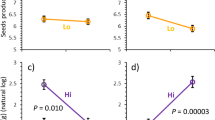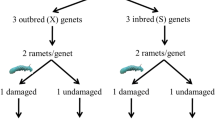Abstract
Plant responses to herbivory include tolerance (i.e. compensatory growth) and defense. Several factors influence the tolerance of a plant following herbivory, including plant genetic identity, site nutrient availability, and previous and/or concurrent herbivory. We studied the effects of these factors on the compensatory response of Salix planifolia ssp. planifolia, a shrub species common in the boreal and subarctic regions of North America. We cloned several genets of S. planifolia and submitted them to simulated root and/or leaf herbivory while varying the nutrient availability. Simulated leaf herbivory was more detrimental to the plant than simulated root herbivory, reducing both above- and below-ground tissue production. Leaf demography was unaffected by either simulated herbivory treatment. There was some compensatory growth following simulated leaf and root herbivory, but only the root compartment responded to increased nutrient availability. Simulated leaf herbivory increased leaf transpiration and reduced stomatal resistance, suggesting increased carbon fixation. The unexpected finding of the experiment was the absence of interactions among factors (genotype, nutrient availability and type of tissue damage) on the compensatory response of S. planifolia. These factors thus have additive effects on the species' compensatory ability.
Similar content being viewed by others
References
Atmospheric Environment Service (1981) Canadian climate normals. Temperature and precipitations, 1951–1980. Environment Canada, Downsview, Ontario
Atmospheric Environment Service (1982) Canadian climate normals. Frost, 1951–1980. Environment Canada, Downsview, Ontario
Belsky AJ (1986) Does herbivory benefit plants? A review of the evidence. Am Nat 127: 870–892
Bowman WD, Conant RT (1994) Shoot growth dynamics and photosynthetic response to increased nitrogen availability in the alpine willow Salix glauca. Oecologia 97: 93–99
Caldwell MM, Richards JH, Johnson DA, Nowak RS, Dzurec RS (1981) Coping with herbivory: photosynthetic capacity and resource allocation in two semiarid Agropyron bunchgrasses. Oecologia 50: 14–24
Chapin FS and McNaughton SJ (1989) Lack of compensatory growth under phosphorus deficiency in grazing-adapted grasses from the Serengeti Plains. Oecologia 79: 551–557
Crawley MJ (1983) Herbivory: the dynamics of animal/plant interactions. Blackwell, Oxford
Danell K, Elmqvist T, Ericson L, Salomonson A (1985) Sexuality in willows and preference by bark-eating voles: defence or not? Oikos 44: 82–90
Danell K, Elmqvist T, Ericson L, Salomonson A (1987) Are there general patterns in bark-eating by voles on different shoot types from woody plants? Oikos 50: 396–402
DeClerck-Floate R, Price PW (1994) Impact of a bud-galling midge on bud populations of Salix exigua. Oikos 70: 253–260
Detling JK, Winn DT, Procter-Gregg C, Painter EL (1980) Effects of simulated grazing by below-ground herbivores on growth, CO2 exchange, and carbon allocation patterns of Bouteloua gracilis. J Appl Ecol 17: 771–778
Elmqvist T, Ericson L, Danell K, Salomonson A (1988) Latitudinal sex ratio variation in willows, Salix spp, and gradients in vole herbivory. Oikos 51: 259–266
Gedge KE, Maun MA (1992) Effects of simulated herbivory on growth and reproduction of two beach annuals, Cakile edentula and Corispermum hyssopifolium. Can J Bot: 70: 2467–2475
Hakulinen J, Julkunen-Tiitto R, Tahvanainen J (1995) Does nitrogen fertilization have an impact on the trade-off between willow growth and defensive secondary metabolism? Trees 9: 235–240
Heichel GH, Turner NC (1983) CO2 assimilation of primary and regrowth foliage of red maple (Acer rubrum L.) and red oak (Quercus rubra L.): response to defoliation. Oecologia 57: 14–19
Herms DA, Mattson WJ (1992) The dilemma of plants: to grow or defend. Q Rev Biol 67: 283–335
Hicks SL, Reader RJ (1995) Compensatory growth of three grasses following simulated grazing in relation to soil nutrient availability. Can J Bot 73: 141–145
Hik DS, Jefferies RL (1990) Increases in the net above-ground primary production of a salt-marsh forage grass: a test of the predictions of the herbivore-optimization model. J Ecol 78: 180–195
Hilbert DW, Swift DM, Detling JK, Dyer MI (1981) Relative growth rates and the grazing optimization hypothesis. Oecologia 51: 14–18
Hjältén J, Danell K, Ericson L (1993) Effects of simulated herbivory and intraspecific competition on the compensatory ability of birches. Ecology 74: 1136–1142
Honkanen T, Haukioja E, Suomela J (1994) Effects of simulated defoliation and debudding on needle and shoot growth in Scots pine (Pinus sylvestris): implications of plant source/sink relationships for plant-herbivore studies. Funct Ecol 8: 631–639
Julkunen-Tiitto R (1986) A chemotaxonomic survey of phenolics in leaves of northern Salicaceae species. Phytochemistry 25: 663–667
Marquis RJ (1984) Leaf herbivores decrease fitness of a tropical plant. Science 226: 537–539
Maschinski J, Whitham TG (1989) The continuum of plant responses to herbivory: the influence of plant association, nutritent availability, and timing. Am Nat 134: 1–19
Masters GJ, Brown VK (1992) Plant-mediated interactions between two spatially separated insects. Funct Ecol 6: 175–179
Mattson WJ, Haack RA (1987) The role of drought stress in provoking outbreaks of phytophagous insects. In: Barbosa P, Schultz JC (eds) Insect outbreaks. Academic Press, New York, pp 365–407
McNaughton SJ (1983) Compensatory plant growth as a response to herbivory. Oikos 40: 329–336
McNaughton SJ, Chapin FS (1985) Effects of phosphorus nutrition and defoliation on C4 graminoids from the Serengeti Plains. Ecology 66: 1617–1629
Müller-Schärer H (1991) The impact of root herbivory as a function of plant density and competition: survival, growth and fecundity of Centaurea maculosa in field plots. J Appl Ecol 28: 759–776
Nowak RS, Caldwell MM (1984) A test of compensatory photosynthesis in the field: implications for herbivory tolerance. Oecologia 61: 311–318
Oesterheld M (1992) Effect of defoliation intensity on aboveground and belowground relative growth rates. Oecologia 92: 313–316
Palo RT (1984) Distribution of birch (Betula spp.), willow (Salix spp.), and poplar (Populus spp.) secondary metabolites and their potential role as chemical defense against herbivores. J Chem Ecol 10: 499–520
Price PW (1991) The plant vigor hypothesis and herbivore attack. Oikos 62: 244–251
Prins AH, Nell HW, Klinkhamer PGL (1992) Size-dependent root herbivory on Cynoglossum officinale. Oikos 65: 409–413
Rank NE (1992) Host plant preference based on salicylate chemistry in a willow leaf beetle (Chrysomela aeneicollis). Oecologia 90: 95–101
Reichman OJ, Smith SC (1991) Responses to simulated leaf and root herbivory by a biennial, Tragopogon dubius. Ecology 72: 116–124
Richards JH (1984) Root growth response to defoliation in two Agropyron bunchgrasses: field observations with an improved root periscope. Oecologia 64: 21–25
Roininen H, Tahvanainen J (1991) Impact of the bud galler, Euura mucronata, on its resources and on the architecture of the willow host, Salix cinerea. In: Roininen H (ed) The ecology and evolution of the host plant relationships among willow-feeding sawflies. University Joensuu Publications in Sciences, Joensuu, Finland, pp
Rosenthal JP, Kotanen PM (1994) Terrestrial plant tolerance to herbivory. Trends Ecol Evol 9: 145–148
Ryle GJA, Powell CE (1975) Defoliation and regrowth in the graminaceous plant: the role of current assimilate. Ann Bot 39: 297–310
Senn J, Haukioja E (1994) Reactions of the mountain birch to bud removal: effects of severity and timing, and implications for herbivores. Funct Ecol 8: 494–501
Steinger T, Müller-Schärer H (1992) Physiological and growth responses of Centaurea maculosa (Asteraceae) to root herbivory under varying levels of interspecific plant competition and soil nitrogen availability. Oecologia 91: 141–149
Strauss SY (1991) Direct, indirect, and cumulative effects of three native herbivores on a shared host plant. Ecology 72: 543–558
Swank SE, Oechel WC (1991) Interactions among the effects of herbivory, competition, and resource limitation on chaparral herbs. Ecology 72: 104–115
Tahvanainen J, Julkunen-Tiitto R, Kettunen J (1985) Phenolic glycosides govern the food selection pattern of willow feeding leaf beetles. Oecologia 67: 52–56
Trumble JT, Kolodny-Hirsch DM, Ting IP (1993) Plant compensation for arthropod herbivory. Annu Rev Entomol 38: 93–119
Vail SG (1992) Selection for overcompensatory plant responses to herbivory: a mechanism for the evolution of plant-herbivore mutualism. Am Nat 139: 1–8
Wallace LL, McNaughton SJ, Coughenour MB (1984) Compensatory photosynthetic responses of three african graminoids to different fertilisation, watering, and clipping regimes. Bot Gaz 145: 151–156
White TCR (1984) The abundance of invertebrate herbivores in relation to the availability of nitrogen in stressed food plants. Oecologia 63: 90–105
Wolff JO (1978) Burning and browsing effects on willow growth in interior Alaska. J Wildlife Manage 42: 135–140
Author information
Authors and Affiliations
Rights and permissions
About this article
Cite this article
Houle, G., Simard, G. Additive effects of genotype, nutrient availability and type of tissue damage on the compensatory response of Salix planifolia ssp. planifolia to simulated herbivory. Oecologia 107, 373–378 (1996). https://doi.org/10.1007/BF00328454
Received:
Accepted:
Issue Date:
DOI: https://doi.org/10.1007/BF00328454




